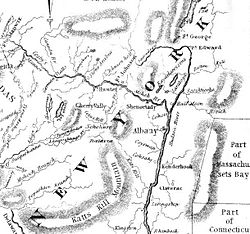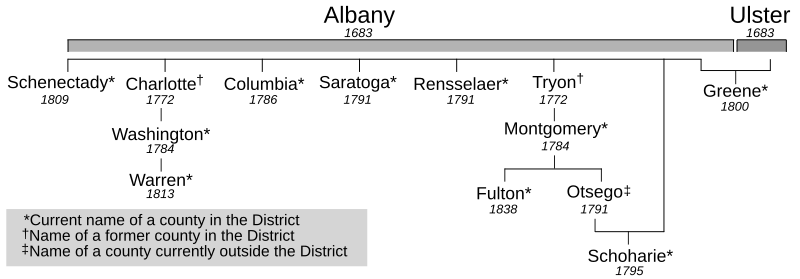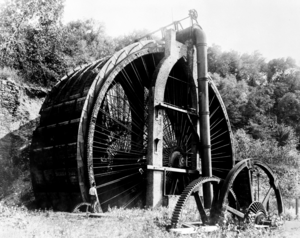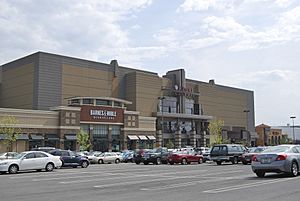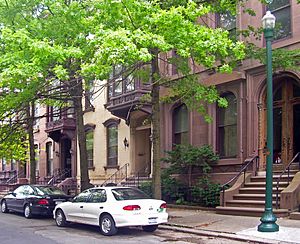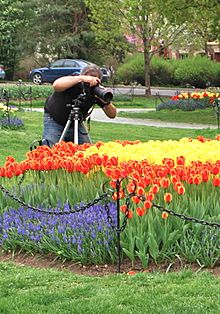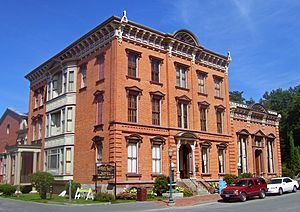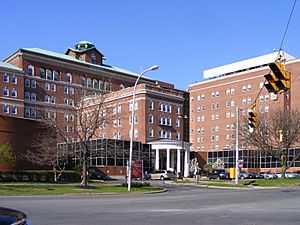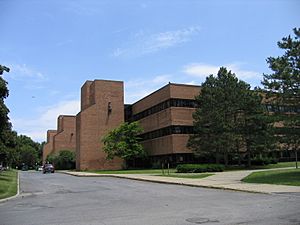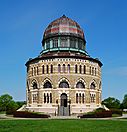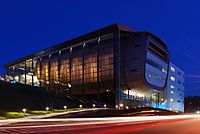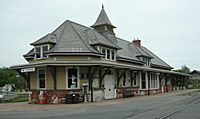Capital District (New York) facts for kids
Quick facts for kids
Capital District
Capital Region
|
|
|---|---|
|
Region
|
|
 |
|
| Etymology: Region of the capital of the state of New York | |
| Country | |
| State | |
| Cities | Albany, Amsterdam, Cohoes, Glens Falls, Gloversville, Hudson, Johnstown, Mechanicville, Rensselaer, Saratoga Springs, Schenectady, Troy, Watervliet |
| Counties | Albany, Columbia, Fulton, Greene, Montgomery, Rensselaer, Saratoga, Schenectady, Schoharie, Warren, Washington |
| Area | |
| • Total | 18,720 km2 (7,228 sq mi) |
| Population
(2020)
|
|
| • Total | 1,238,717 |
| • Density | 66.169/km2 (171.378/sq mi) |
| Time zone | UTC−5 (EST) |
| • Summer (DST) | UTC−4 (EDT) |
| Area code | 518, 838 |
| Website | Capital District Regional Planning Commission Capital District Transportation Committee |
The Capital District, also known as the Capital Region, is a large area in New York State. It surrounds Albany, which is the state's capital city. This region was first settled by the Dutch in the early 1600s. Later, in 1664, it came under English control. Albany has been the official capital of New York since 1797. The Capital District is famous for many important historical events that happened even before the United States became an independent country. These include the Albany Plan of Union and the Battles of Saratoga.
Contents
- What's in a Name? The Capital District's Story
- A Look Back: History of the Capital District
- Where is the Capital District?
- What's the Weather Like?
- City Views and Buildings
- Life and Culture in the Capital District
- Economy: How People Make a Living
- Who Lives Here? Population and Demographics
- Who Represents the Capital District in Congress?
- Learning in the Capital District: Schools and Colleges
- Getting Around: Transportation in the Capital District
- Images for kids
- See also
What's in a Name? The Capital District's Story
The name "Capital District" first appeared in the late 1860s. It was used for a police district in the Albany area.
By the 1910s, many groups and businesses in the area started using "Capital District" in their names. For example, there was the Capital District Conference of Charities and Corrections in 1913. There was also the Capital District Recreation League, formed in 1916. This group even suggested creating a large "Capital District Park."
Fun Nicknames for the Capital Region
People sometimes call the Capital District by other names. These include Capitaland, Metroland, the Tri-City Area, and Tech Valley. You might also hear it called "the 518," which is the main telephone area code for the region.
The Capital District is part of a larger area known as "Tech Valley." This name highlights the many technology companies that have moved here. The Tech Valley region is quite big, stretching from the Canadian border all the way south to Orange County. In 2011, New York State officially named this area the "Capital Region." It includes eight counties and about 1.1 million people.
A Look Back: History of the Capital District
Early Settlements and Conflicts
European settlement in this area began in 1609. That's when Henry Hudson sailed up the Hudson River for the Dutch. At the same time, Samuel Champlain explored south from Lake Champlain for France. Soon, the French and Dutch fought over the fur trade. Both sides made friends with different Native American tribes.
In 1630, Kiliaen van Rensselaer started a large Dutch settlement called the Manor of Rensselaerswyck. This manor covered much of what is now the Capital District. In 1664, the English took control from the Dutch. The English focused on building towns and farms. The French were more interested in hunting furs and trading.
Conflicts happened when the French built Fort Carillon and the British built Fort William Henry. Both forts were built to control important travel routes.
Albany was given the right to buy land in areas like Schaghticoke and Fort Hunter. Arent van Curler founded Schenectady in 1662. Fort Saratoga was built in 1691, and Greenbush (now Rensselaer) was settled in the 1620s.
The French and Indian War brought major battles to the Capital District. After the French were defeated, more land became open for settlement. During the American Revolution, there was more fighting. The Battle of Saratoga, which happened in Stillwater, was a major turning point in the war. In 1776, General Philip Schuyler built a small fleet of ships in Whitehall. These ships were used in the Battle of Valcour Island. Because of this, Whitehall is known as the birthplace of the United States Navy.
After the Revolution, more towns grew west and north of Albany. These included Waterford, Troy, Lansingburgh, and Watervliet. West of Schenectady, towns like Fonda and Fultonville also grew.
How the Counties Were Formed
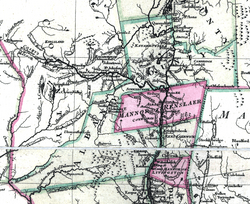
The entire Capital District was once part of the original Albany County, created in 1683. Over time, this large county was divided into smaller ones. In 1772, Charlotte County and Tryon County were formed from parts of Albany County. Charlotte County later became Washington County in 1784. Tryon County was renamed Montgomery County in 1784.
Albany County was the most populated county in New York in 1774. But as new counties were created from it, its population changed. Columbia County was formed in 1786. Rensselaer and Saratoga counties were created in 1791. Schoharie County was formed in 1795. Greene County was created in 1800. Schenectady County was formed in 1809, and Warren County in 1813. Fulton County was the last county in the Capital District to be formed, in 1838.
Growth of Cities and Transportation
The Champlain and Erie canals opened in the 1820s. These canals connected the area to the Great Lakes and the Saint Lawrence River. This led to a big increase in factories and people moving to the region. Soon after, in 1831, the first railway in New York State was built between Albany and Schenectady.
Railroads made Albany an even more important transportation center. In 1853, many railroads were combined to form the New York Central Railroad. Its main office was in Albany for a while.
Industries grew quickly. Gloversville became known for making gloves. Cohoes was called the "Spindle City" because of its large cotton mills. Troy was famous for its iron works and later for making shirt collars. In 1887, Thomas Edison moved his factory to Schenectady. In 1892, Schenectady became the main office for General Electric Company (GE). Another big company, American Locomotive Company (ALCO), was also based in Schenectady. Because of GE and ALCO, Schenectady earned nicknames like "Electric City." These industries led to many new inventions, like the horseshoe machine and improvements in electricity.
The Rise of Suburbs and City Changes
Starting in the 1980s, the population of Albany city began to shrink. At the same time, the suburbs around Albany grew a lot. This happened for several reasons. New highways made it easier to live in the suburbs and drive to work. There wasn't much open land left in the cities for new buildings. Also, shopping centers started to move to the suburbs.
Many factories and businesses in the cities faced challenges. General Electric moved part of its main office from Schenectady in the mid-1980s. The focus shifted to the suburbs, where there was more space for offices and homes. The first technology park in the region was built in North Greenbush in the 1980s.
Shopping also moved to the suburbs. The area's first "suburban" style shopping center, Westgate Plaza, opened in Albany in 1957. Two years later, Stuyvesant Plaza was built outside Albany. In 1966, Colonie Center opened in Colonie. It was the first enclosed shopping mall in the area. Big stores like Macy's and Sears chose to open in Colonie Center instead of downtown Albany.
More enclosed malls were built outside Albany, like Mohawk Mall and Aviation Mall. The first mall built in a downtown area was the Amsterdam Mall in 1977. Crossgates Mall, a very large mall, opened in Guilderland in 1984. It is now the fourth-largest mall in New York State.
Recently, cities like Albany have been working to bring more people back to their downtown areas. They are building new apartment buildings and improving city centers. Other cities like Schenectady, Glens Falls, and Hudson are also working on similar projects to make their downtowns lively again.
Where is the Capital District?
| Historical population | |||
|---|---|---|---|
| Census | Pop. | %± | |
| 1900 | 334,120 | — | |
| 1910 | 384,177 | 15.0% | |
| 1920 | 408,398 | 6.3% | |
| 1930 | 456,755 | 11.8% | |
| 1940 | 465,643 | 1.9% | |
| 1950 | 514,490 | 10.5% | |
| 1960 | 680,119 | 32.2% | |
| 1970 | 746,660 | 9.8% | |
| 1980 | 771,290 | 3.3% | |
| 1990 | 809,443 | 4.9% | |
| 2000 | 825,875 | 2.0% | |
| 2010 | 870,716 | 5.4% | |
| 2020 | 899,262 | 3.3% | |
| 2022 (est.) | 904,617 | 3.9% | |
| U.S. Decennial Census | |||
The Capital District includes 11 counties: Albany, Columbia, Fulton, Greene, Montgomery, Rensselaer, Saratoga, Schenectady, Schoharie, Warren, and Washington. The southern part of the Capital District is sometimes considered part of the Hudson Valley.
These 11 counties have 13 cities and 143 towns. There are also 62 villages located within these towns. The Capital District also includes parts of the southern Adirondack Mountains.
| County | 2022 Estimate | 2020 Census | Change | Area | Density | |
|---|---|---|---|---|---|---|
| Albany County | 315,811 | 314,848 | +0.31% | 522.80 sq mi (1,354.0 km2) | 604/sq mi (233/km2) | |
| Saratoga County | 238,797 | 235,509 | +1.40% | 809.98 sq mi (2,097.8 km2) | 295/sq mi (114/km2) | |
| Schenectady County | 160,093 | 158,061 | +1.29% | 204.52 sq mi (529.7 km2) | 783/sq mi (302/km2) | |
| Rensselaer County | 159,853 | 161,130 | −0.79% | 652.43 sq mi (1,689.8 km2) | 245/sq mi (95/km2) | |
| Schoharie County | 30,063 | 29,714 | +1.17% | 621.82 sq mi (1,610.5 km2) | 48/sq mi (19/km2) | |
| Total | 904,617 | 899,262 | +0.60% | 2,811.55 sq mi (7,281.9 km2) | 322/sq mi (124/km2) | estref= |
Where is the Capital District Located?
 |
Adirondack Mountains | North Country | Vermont |  |
| Central New York | Massachusetts | |||
| Southern Tier | Mid-Hudson Valley Region | Connecticut |
What's the Weather Like?
| Weather chart for Albany | |||||||||||||||||||||||||||||||||||||||||||||||
|---|---|---|---|---|---|---|---|---|---|---|---|---|---|---|---|---|---|---|---|---|---|---|---|---|---|---|---|---|---|---|---|---|---|---|---|---|---|---|---|---|---|---|---|---|---|---|---|
| J | F | M | A | M | J | J | A | S | O | N | D | ||||||||||||||||||||||||||||||||||||
|
2.7
31
13
|
2.3
34
16
|
3.2
45
25
|
3.3
57
36
|
3.7
70
47
|
3.8
78
55
|
3.5
82
60
|
3.7
80
58
|
3.3
71
50
|
3.2
60
39
|
3.3
48
31
|
2.8
36
20
|
||||||||||||||||||||||||||||||||||||
| temperatures in °F precipitation totals in inches source: USTravelWeather.com |
|||||||||||||||||||||||||||||||||||||||||||||||
|
Metric conversion
|
|||||||||||||||||||||||||||||||||||||||||||||||
The Capital District has a humid continental climate. This means it has cold, snowy winters and hot, wet summers. The region usually gets less snow and rain than other parts of New York State. For example, between 1980 and 2010, the Albany area received much less snow than Syracuse or Buffalo. It also received less rain than cities further south in New York.
Albany gets about 36.2 inches of rain each year. It snows about 63 inches annually. The area gets most of its snow from big winter storms called Nor'easters. The Capital District also gets about 69 sunny days each year.
City Views and Buildings
Unique Architecture
The Capital District has a long history, so you can see many different building styles. Some old Dutch farmhouses are still standing in rural towns. The Van Ostrande-Radliff House (1728) in Albany and the Rosa House in Schenectady (before 1700) are the oldest homes in those cities. In 1885, a national magazine asked readers to name the top ten most beautiful buildings in the country. Two buildings in Albany made the list: Albany City Hall and the New York State Capitol.
Troy has special architectural features, like decorative ironwork and cast-iron storefronts. It also has many beautiful stained-glass windows by Tiffany. The Capital District has many brownstone buildings, especially in Albany's Center Square and Troy's Washington Park.
Schenectady's Stockade neighborhood shows homes from all periods of its 300-year history. These include Dutch, Federal, and Victorian styles. The GE Realty Plot in Schenectady was built by General Electric for its employees. The houses there are in different revival styles, like Tudor and Spanish Colonial. The first all-electric house was built by GE in the Realty Plot to show off its products.
Fun Festivals and Events
One of the biggest events in the Capital District is the Tulip Fest. It happens every spring in Albany's Washington Park. This tradition started in 1948 when the tulip became Albany's official flower. The Queen of the Netherlands even named a special tulip variety for Albany. The first Tulip Fest was in 1949. It includes old traditions like sweeping State Street and crowning a Tulip Queen. The African-American tradition of Pinksterfest was also added to the Tulip Fest. About 80,000 people attended in 2010.
Troy used to host the largest Flag Day parade in the United States every year until 2017. First Night celebrations are held in Saratoga Springs. Albany now has a "WinterFest" instead of First Night.
Other big festivals celebrate different cultures. The Albany LatinFest has been held since 1996 and attracts many people. In Schenectady, the Guyanese community celebrates Guyanese Family Fun Day. PolishFest is a three-day event celebrating Polish culture in Colonie.
Entertainment and Shopping
The Capital District has many large shopping malls. Two of the biggest are Crossgates Mall in Guilderland and Colonie Center in Colonie.
In winter, the Capital District offers many activities. You can go skiing, snowboarding, tubing, ice fishing, and snowshoeing. Some popular ski resorts include West Mountain and Gore Mountain. State parks and other areas also have cross-country skiing trails. The Albany Pine Bush Preserve has over 18 miles of trails for snowshoeing.
Lake George also hosts a winter carnival every weekend in February.
Life and Culture in the Capital District
Local Culture
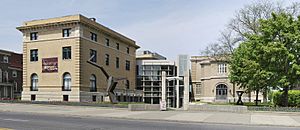
Albany often ranks high as a great place for culture. It has many museums, historical sites, art galleries, and festivals. The Capital District has played a big part in the history of Santa Claus in the United States. This includes the first written mention of Santa (Sinterclaas) in 1675. Also, the famous poem 'Twas the Night before Christmas was first published here in 1823.
Famous Foods from the Region
The Capital District is the birthplace of several well-known American foods. Potato chips were invented by chef George Crum in Saratoga Springs. The club sandwich was also created in Saratoga Springs in 1894. Pie à la Mode was first made at the Cambridge Hotel in Cambridge, Washington County, in the 1890s.
Long ago, there were so many Sturgeon fish in the Hudson River that people called them "Albany beef."
Sports Teams and Events
The Siena College men's basketball team, the Siena Saints, has played in the NCAA Tournament many times since 1988. Their rivals, the Great Danes from the University at Albany, have also appeared several times.
Union College won the NCAA Division 1 National Championship in men’s college hockey in 2014. Their rival, RPI, won the title in 1985 and 1954.
Professional Sports Teams
- Albany Empire (Arena Football League)
- Albany Legends (International Basketball League)
- Tri-City ValleyCats (Frontier League baseball team)
- New York Buzz (World Team Tennis)
Economy: How People Make a Living
The economy of the Capital District relies heavily on the state government. The region's economy has three main parts: state government, health care, and education. Many important banks also have their main offices here.
The Rise of Tech Valley
Tech Valley is a special name for the eastern part of New York State. It includes the Capital District and the Hudson Valley. This name started in 1998 to show that the greater Albany area is a strong competitor in high-tech industries. It's like a smaller version of Silicon Valley in California.
The Tech Valley area has grown a lot in computer hardware and nanotechnology. This growth is supported by universities like Rensselaer Polytechnic Institute and the State University of New York Polytechnic Institute. In 2021, GlobalFoundries, a company that makes computer chips, moved its main office to Malta, New York in Saratoga County.
The Capital Region is one of the few areas in the country where businesses spend over $1 billion each year on research and development. A lot of this money goes into making computer chips. In fact, in 2019, more patents for semiconductor devices came from the Capital Region than from any other state except California.
Who Lives Here? Population and Demographics
The Capital District is the wealthiest metropolitan area in New York State outside of New York City. In 1999, the average household income was about $86,787. Also, more adults here have college degrees compared to the national average.
Different Ways to Count the Population
The Albany-Schenectady-Troy NY Metropolitan Statistical Area (MSA) is a way the government defines a populated area. This MSA includes Albany, Rensselaer, Saratoga, Schenectady, and Schoharie counties. In 2020, this area had a population of 899,262 people.
The Albany-Schenectady NY Combined Statistical Area (CSA) is an even larger area. It includes 10 of the 11 counties in the Capital District. This CSA combines the Albany-Schenectady-Troy MSA with other smaller areas. As of 2020, the Albany-Schenectady NY Combined Statistical Area had a population of 1,190,727. If you add Greene County, the total population for the Capital District in 2020 was about 1,238,658.
Who Represents the Capital District in Congress?
The Capital District is divided into parts of three different congressional districts. These are New York's 19th, 20th, and 21st congressional districts. As of 2023, these districts are represented by Marc Molinaro (Republican), Paul Tonko (Democrat), and Elise Stefanik (Republican). These people are elected to speak for the region in the United States Congress.
Learning in the Capital District: Schools and Colleges
School Districts
In Albany, Rensselaer, Saratoga, and Schenectady counties, there are 54 public school districts. These districts work with special organizations called Boards of Cooperative Educational Services (BOCES). Some school districts cross county lines. The smallest district is North Greenbush Common School District. The largest is Shenendehowa Central School District, with many students.
Some of the top-ranked public high schools in the Capital District include Shaker High School in Latham, Niskayuna Central High School in Schenectady, and Bethlehem Central Senior High School in Delmar.
Colleges and Universities
The biggest school in the Capital District is the University at Albany. It is one of the four main university centers in the State University of New York system.
Union College was founded in 1795. It is the college where former President Chester A. Arthur studied.
Rensselaer Polytechnic Institute (RPI) in Troy is the oldest technical university in the English-speaking world that has been open continuously.
Getting Around: Transportation in the Capital District
Albany has always been important for transportation. From early roads and canals to the first passenger railroad in New York, it has a long history. Today, major highways, Amtrak trains, and the Albany International Airport keep the Capital District a key travel hub in the Northeastern United States.
Major Highways
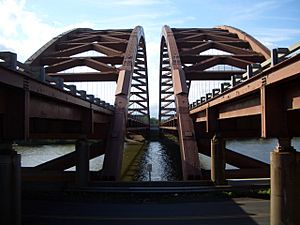
Two major highways, Interstate 90 (I-90) and Interstate 87 (I-87), meet in the Capital District. This meeting point is one of the busiest exits on the New York State Thruway. I-87 runs north and south, and I-90 runs east and west. Older roads like US Route 9 and US Route 5 are still important for local travel.
Public Transportation
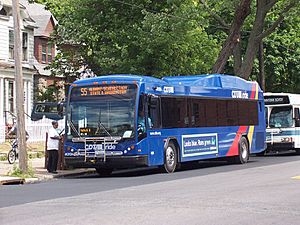
The main counties of the Capital District have bus service provided by the Capital District Transportation Authority (CDTA). They have bus hubs in Albany, Schenectady, and Troy. There are also express buses between Saratoga Springs and Albany. Other towns and cities in the region also have their own bus services.
Intercity Bus Service
Several cities in the Capital District have bus service to places outside the region:
- Albany: Greyhound Lines, Trailways, and Peter Pan Bus Lines all have buses that leave from downtown.
- Schenectady: Greyhound and Trailways buses leave from a downtown station.
- Glens Falls: Greyhound and Trailways also serve a downtown station here.
- Gloversville: Greyhound and Trailways buses leave from a downtown station.
- Saratoga Springs: Greyhound offers service from Saratoga Springs.
- Rensselaer: Megabus has regular service from the Albany-Rensselaer Train Station to New York City.
Airports in the Region
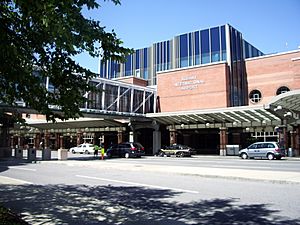
The Capital District has many airports. The Federal Aviation Administration (FAA) has identified 13 important airports in the region.
- Albany International Airport in Colonie, Albany County, is the only airport with commercial flights.
- Other airports include Schenectady County Airport, Saratoga County Airport, and Columbia County Airport. These are mainly for private planes and smaller aircraft.
Train Service
Amtrak has several train routes that serve stations in the Capital District. These routes connect the region to cities like Montreal, New York City, Buffalo, Toronto, and Chicago. Amtrak stations in the region include:
- Albany-Rensselaer station in Rensselaer County
- Schenectady station in Schenectady County
- Saratoga Springs station in Saratoga County
- Fort Edward station in Washington County
- Hudson station in Columbia County
- Amsterdam station in Montgomery County
- Whitehall station in Washington County
Images for kids
See also
 In Spanish: Distrito Capital (Nueva York) para niños
In Spanish: Distrito Capital (Nueva York) para niños


